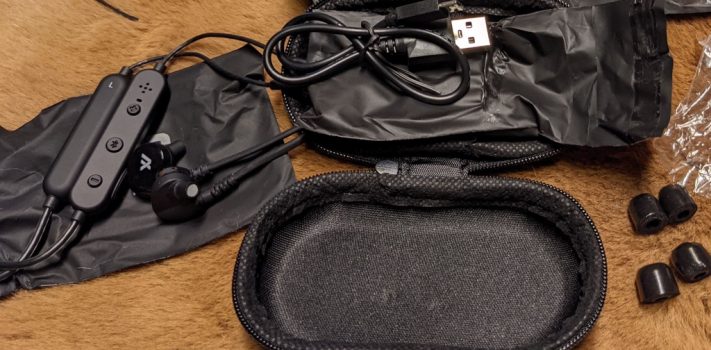Axil GS Extreme Earbuds transmit and even amplify ambient noises while filtering out the dangerously loud sounds that can result in hearing loss. I found the earbuds to work well in setting like the range, running a chainsaw outdoors, running a circular saw inside, or driving while a dog is baying near my ear. These earbuds have become my preferred method of hearing protection.
The Backstory
I have noticed that ear muffs and rifle stocks do not always play well together. The muffs and the stock somehow seem to get in each other’s way, with the stock banging the muffs, and the muffs making it difficult to acquire the sights. So when I ran across Axil GS Extreme Earbuds recently, I wanted to give them a try. I contacted Axil, and they were kind enough to provide a sample for testing and evaluation.
While the earbuds were in transit, Axil recommended that I watch a short video (4:28) with tips about how to get the best performance out of the earbuds. There were a number of major points that I took away from the video:
1. Proper fit is vital to achieving good results from the earbuds. The buds come with differing sized tips that can be used to achieve proper fit. For ears of an unusual size or shape, it is possible to order custom fitted earbuds.
2. If one is using foam tips, they should be compressed prior to inserting the earbuds. The earbuds should be inserted deep into the ear canal with a twisting motion.
3. In extremely loud environments, the volume of the earbuds should be turned down.
Opening the Box
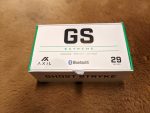 Less than a week after they were shipped, the earbuds arrived in a USPS first-class package. The box noted that the earbuds provide between 19 and 29 decibels in sound reduction, depending on whether one uses the silicon or the foam tips. The box also notes that the earbuds are suitable for shooting, loud events, yard work, and construction. They provide “studio quality sound performance”, and amplify sounds up to 8 times louder than normal hearing. They automatically mute all sounds over 95 decibels.
Less than a week after they were shipped, the earbuds arrived in a USPS first-class package. The box noted that the earbuds provide between 19 and 29 decibels in sound reduction, depending on whether one uses the silicon or the foam tips. The box also notes that the earbuds are suitable for shooting, loud events, yard work, and construction. They provide “studio quality sound performance”, and amplify sounds up to 8 times louder than normal hearing. They automatically mute all sounds over 95 decibels.
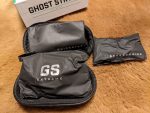
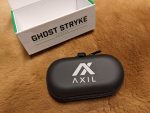 The earbuds are Bluetooth 5.0 enabled, have a 12 hour battery life, and fully recharge in 1.5 hours. They are also characterized as “sweat resistant”. When I cut the seal and opened the box, I found a nicely padded black zippered nylon case inside. The case contained three black plastic pouches. One of the pouches contained the earbuds. The second pouch contained the tips. The third pouch contained a quickstart guide and a micro-usb charging cord.
The earbuds are Bluetooth 5.0 enabled, have a 12 hour battery life, and fully recharge in 1.5 hours. They are also characterized as “sweat resistant”. When I cut the seal and opened the box, I found a nicely padded black zippered nylon case inside. The case contained three black plastic pouches. One of the pouches contained the earbuds. The second pouch contained the tips. The third pouch contained a quickstart guide and a micro-usb charging cord.
The quickstart guide recommended inserting the earbuds before turning them on in order to avoid feedback during the insertion process.
I tried inserting the earbuds using the large foam tips first. I found the earbuds to be quite comfortable. They were also effective at allowing me to hear normal ambient noises when turned on. The Bluetooth paired easily with my phone, and provided excellent sound quality for the media files I played.
The Range Test
A couple of days after the earbuds arrived, I took them to the range behind my barn, where I was testing a rifle chambered in .243 Winchester.
When I inserted the earbuds and turned them on, I could hear the breeze whispering in the tops of the trees just as easily as I could hear it prior to inserting the earbuds.
When I fired the rifle, I could easily hear the sound of firing that was below 95 decibels, but the portion above 95 decibels was filtered out. So it was quite comfortable to fire the rifle without unpleasant and hearing-damaging volume, while still being able to clearly hear background noises. This would be a significant advantage while hunting. One could hear the sounds of game movement (amplified if desired) without the risk of hearing loss when firing.
It was also nice to not have my ear muffs clanking against the stock of the rifle.
The Chainsaw Test
A week later, I inserted the earbuds before heading outside for a morning’s work.
After cleaning and stoking the outside wood boiler, I put on my protective gear, and fired up a chainsaw. For more than an hour I cut wood. The earbuds effectively filtered out the upper range of the chainsaw noise, while allowing ambient noise to be clearly heard whenever the saw was not running. I was very impressed.
The Circular Saw Test
A week later, my daughter asked me to repair a broken step in her basement stairs. This would involve using a circular saw in an enclosed space. I inserted the earbuds, turned them on, and went to work. They did an excellent job. I could hear ambient noises like the furnace kicking on in the background, without being bothered by the noise of the saw in any way.
When I was done fixing the step, I went outside to check the condition of the front porch steps. The December wind gusted off of a nearby lake. The earbuds picked up some wind noise, like microphones often do in breezy conditions. This was the very first time the earbuds had produced a distracting noise.
The Beagle Test
Some dogs ride well in the car. Some dogs don’t. My dog falls into the latter category. I have heard that the word “beagle” is derived from the French word for “loud mouth.” If that is the case, the label fits my dog very well. His bay is unpleasantly loud at close range or in enclosed spaces.
My mom is currently under hospice care. We have caregivers scheduled to be with her all the time. Recently one of the care givers came down with Covid, and needed a sub. My wife filled in at the last minute.
We decided that I would take the dog over to my mom’s house during my lunch hour to keep my wife and mom company. Then I would take him home when the night-time care giver arrived. I knew from past experience that the dog would start baying loudly as soon as the car started moving, and would continue to do so at regular intervals until we arrived at our destination.
With that in mind, I put in the Axil earbuds and turned them on prior to getting in the car. It is amazing how much they helped. The dog had his front paws on the back of my seat, baying loudly inches from my ears. He continued to do this throughout a 20 minute drive. Thanks to the earbuds, the part of his bay that was louder than 95 dB was filtered out. It was nice to be able to hear ambient noises, and to not have my ears ringing from the baying of the hound. I had a similar experience coming home.
Based on these experiences, I award these earbuds the Tucker the Beagle Seal of Approval.
Decibels
The decibel (dB) scale begins at 0 dB, which is the quietest sound detectable by a healthy human ear. The decibel scale is logarithmic, with every three dB increase representing a doubling of acoustic power. The human ear also functions logarithmically, so that when a sound is perceived to be twice as loud, it is actually about 10 dB louder, or about 10 times more powerful.
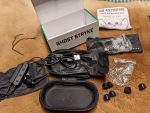 Hearing damage is a result of both acoustic power and the length of exposure. Humans can typically tolerate about two hours at 91 dB without hearing loss, less than 15 minutes at 100 dB, and about one minute at 112 dB. At 140 dB or above, hearing damage is instantaneous. Gunfire typically ranges in the 155 to 165 dB range, with shorter barrels and more powerful rounds creating the most noise. The 29 dB of protection provided by the Axil earbuds reduces even the noise of comparatively loud shots into acceptable ranges.
Hearing damage is a result of both acoustic power and the length of exposure. Humans can typically tolerate about two hours at 91 dB without hearing loss, less than 15 minutes at 100 dB, and about one minute at 112 dB. At 140 dB or above, hearing damage is instantaneous. Gunfire typically ranges in the 155 to 165 dB range, with shorter barrels and more powerful rounds creating the most noise. The 29 dB of protection provided by the Axil earbuds reduces even the noise of comparatively loud shots into acceptable ranges.
Hearing Protection History
The ancient Greek epic poem The Odyssey contains what may be the oldest historic reference to hearing protection. There is an episode in which the hero of the story, Odysseus, and his crew must sail past the Island of the Sirens. The beautiful song of the Sirens would irresistibly draw those who could hear them to cast themselves into the sea and swim for shore, only to be crushed on jagged rocks by heavy surf. In order to protect his crew from this dismal fate, Odysseus plugged their ears with beeswax. He commanded the crew, in turn, to bind him to the mast and to refuse his pleas for release as long as they remained within hearing distance of the Island. In this manner, Odysseus became the only human to hear the song of the Sirens and survive.
Several hundred years later Hippocrates, the Father of Medicine, observed that tinnitus (ringing in the ears) resulted from prolonged exposure to noise. So far as I know, he did not suggest any way of protecting against this problem, other than perhaps avoiding prolonged exposure to noise.
By the end of the American Civil War, about one third of Union Army soldiers displayed signs of hearing loss. Following World War 1, between ten and twenty percent of surviving French soldiers received pensions due to severe hearing loss.
Blocking the ear canal with fingers in the ears is surprisingly effective at reducing excessive noise, but becomes impractical when someone needs to actually use their hands.
The first earplugs were patented in 1864, with the first disposable earplugs coming in 1914. The development of foam earplugs in the 1970s was a significant improvement.
Modern electronic earplugs and earmuffs provide the transmission and even amplification of ambient noise while filtering out damaging levels of sound. The Axil earbuds fall into this category.
Conclusions
I was very pleased with the Axil GS Extreme Earbuds. Whether shooting, using noisy power tools, or transporting the dog across town, they filtered out hearing-damaging levels of sound while allowing me to hear normal background noise. They were so comfortable that I tended to forget that I was wearing them. They provide amazingly good sound quality as a Bluetooth headset. The only performance drawback that I noted was some unwanted noise artifacts under windy conditions. I highly recommend these earbuds for field use.
Disclaimer
Axil was kind enough to provide me with their GS Extreme Earbuds for testing and evaluation. I tried not to let their kindness influence my evaluation of their product, and I believe that I have succeeded. I did not receive any other financial or other inducements to mention any other vendor, product, or service in this article.

